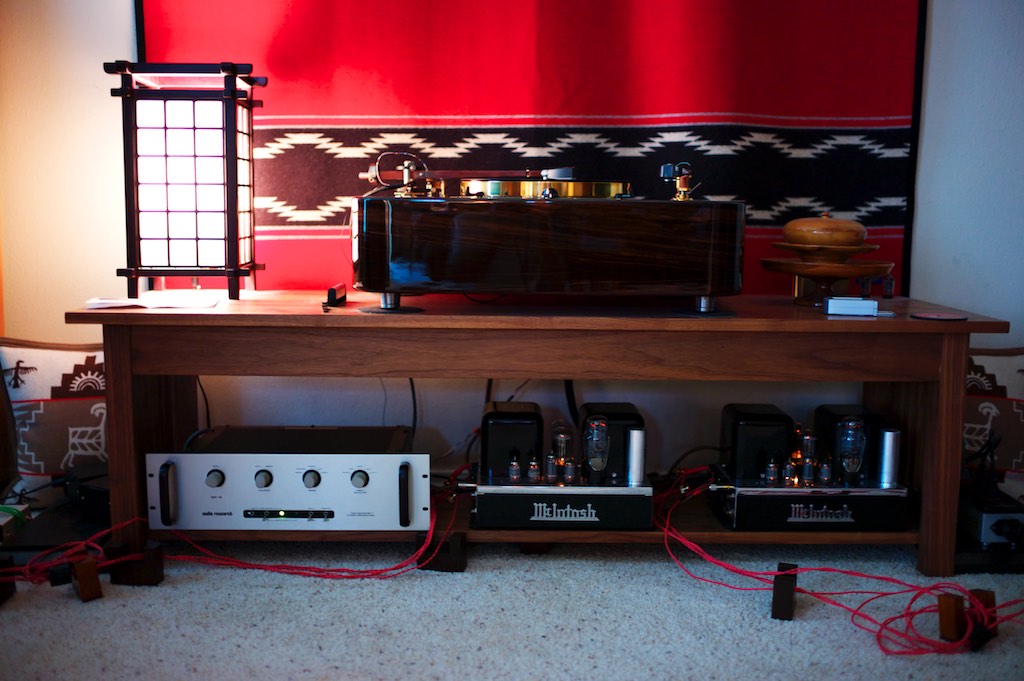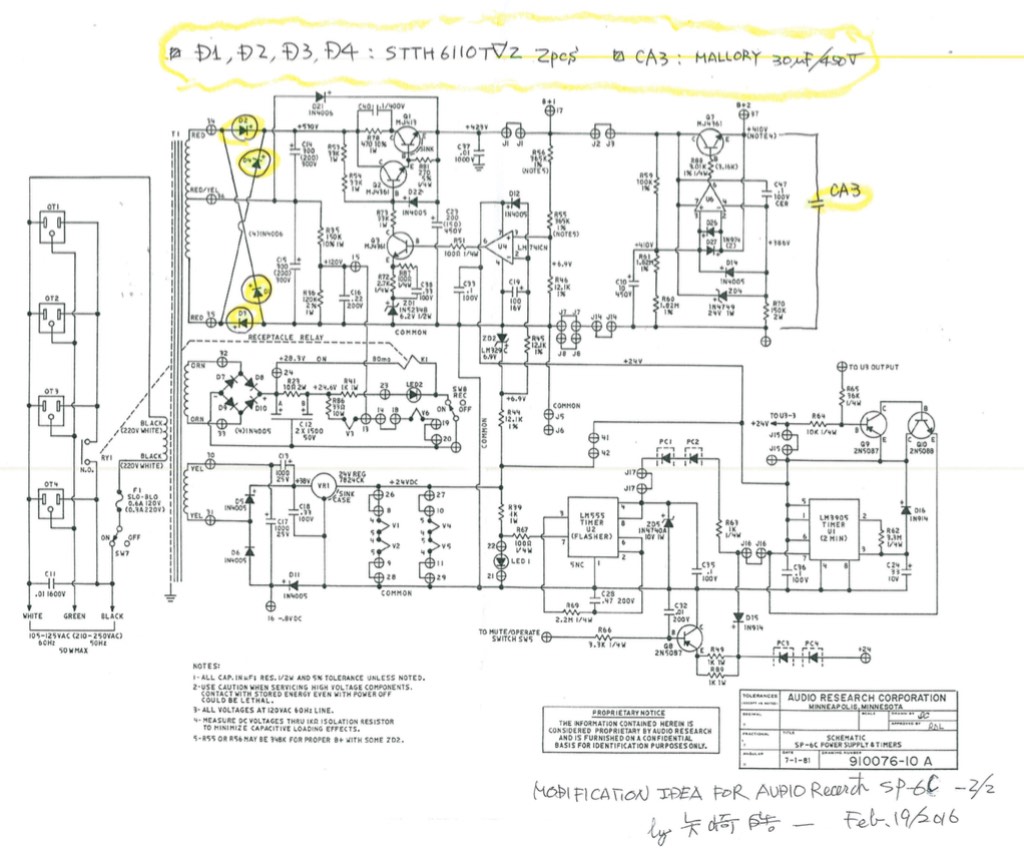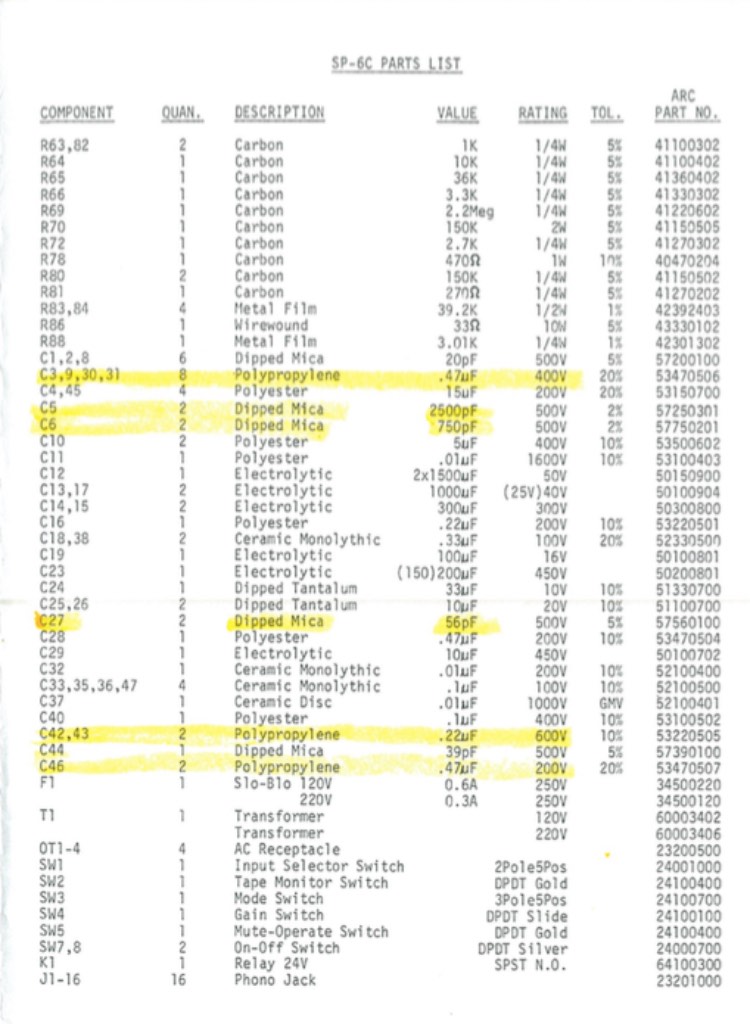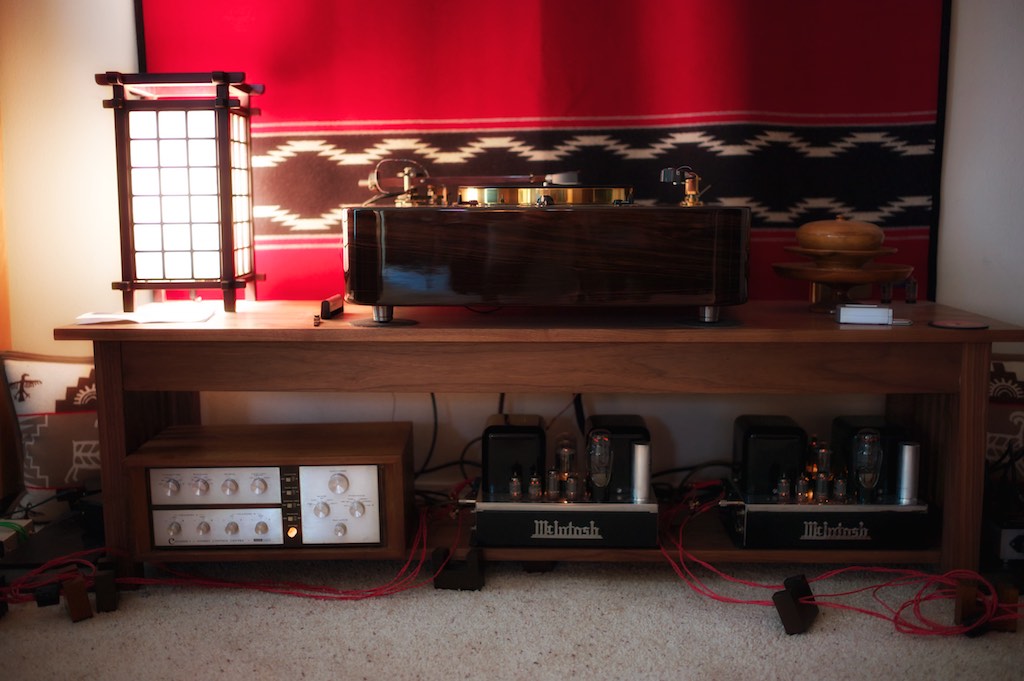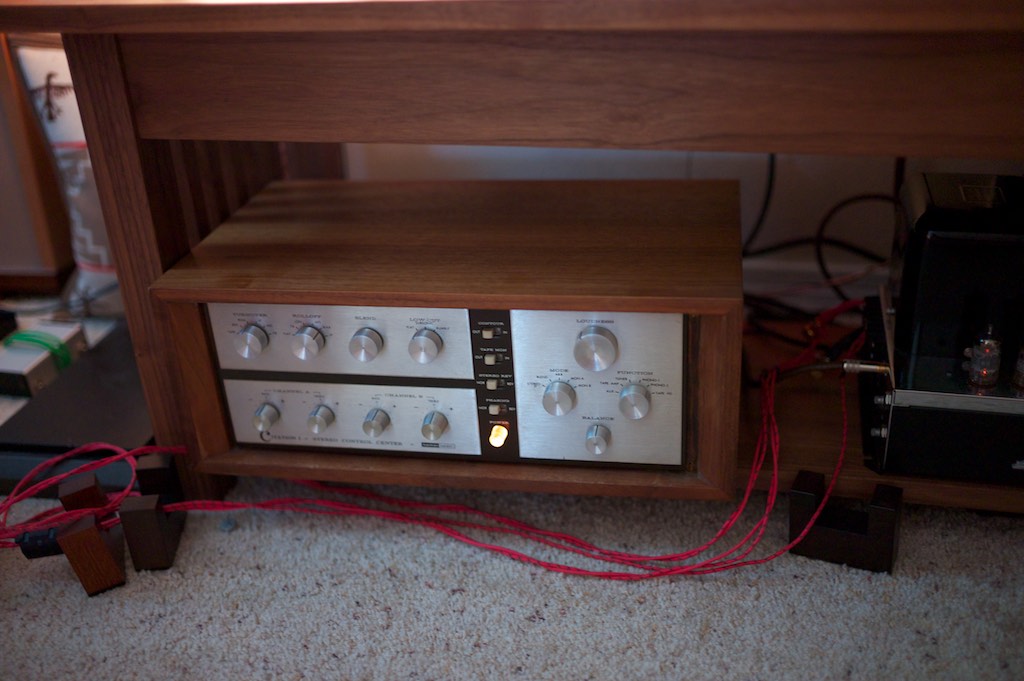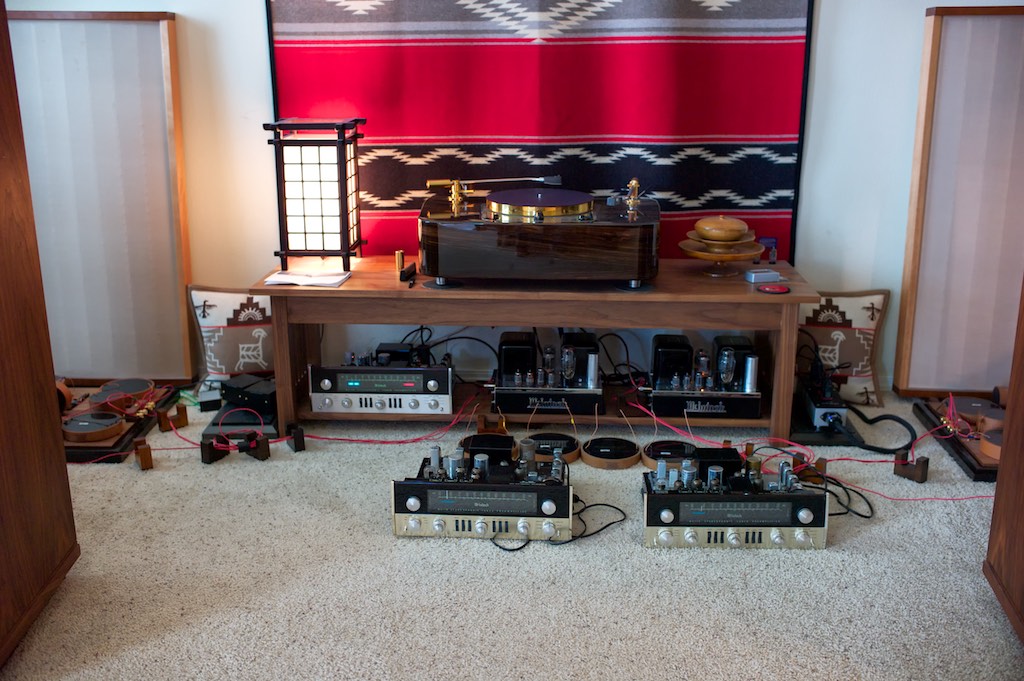Ron, Leo, and I got together to do a little listening to a variety of vintage preamplifiers last weekend, the Audio Research SP-6B, the Harmon Kardon Citation 1, and the McIntosh MX110.
First we listened to Ron's vintage Audio Research SP-6B preamplifier so we could get a performance baseline for it, as we are getting ready to embark on an exciting Audio Research SP-6B adventure!
Above you can see the modifications for the vintage Audio SP-6 Adventure that Yazaki-san has proposed. I'll talk more about the modifications in a future post.
There's quite a few versions of the the Audio Research SP-6 series of preamplifiers: the SP-6, SP-6A, SP-6B, SP-6C, and SP-6E, and it is the Audio Research SP-6B like Ron's that some SP-6 aficionados consider to be the best sounding of the SP-6 series.
We have been wondering if an SP-6C type circuit (as in the schematics above) could reach an even higher level of performance, given that the SP-6C's circuit and operating points are quite similar to the renowned vintage Marantz 7 preamplifier.
But back to Ron's stock vintage Audio Research SP-6B.
We let Ron's SP-6B warm up for quite a while, then we installed it into my Westminster Royal SE system in place of my usual vintage McIntosh MX110Z tuner-preamplifier.
We listened to a fair amount of music with the SP-6B, and concluded that was a nice sounding vintage preamplifier, with an overall presentation that was warm, detailed, and liquid sounding.
The SP-6B wasn't quite as refined sounding in the high-frequencies as the modified vintage McIntosh MX110Z tuner-preamplifiers, but still a very enjoyable overall presentation that served the music well.
Even in its stock state, the vintage Audio Research SP-6B is an easy recommendation for a vintage preamplifier that won't break the bank, and musically it will play circles around a lot of modern preamplifiers that command much higher prices.
More to come on this vintage jewel!
Next up for a listen was Ron's vintage Harmon Kardon Citation 1 vacuum tube preamplifier (circuit below).
If you read my review of the Leben RS-30EQ phono equalizer back in Positive Feedback Issue 43, you'll see that I discussed some design aspects of the Citation IV and its influence on the design of the RS-30EQ (both the Citation 1 & IV use CR RIAA equalization):
"A little background on the design of the RS-30EQ: Hyodo San divides classic valve phono stages into two basic design genres: those like the Marantz Model 7 that use negative feedback (NFB) to achieve RIAA phono equalization; and those like the Harman Kardon Citation IV that use no NFB, and use capacitors and resistors (CR) to achieve RIAA equalization (and which Hyodo San considers to be "a masterpiece" of phono preamplifier design).
The vintage Marantz Model 7 uses three stages of 12AX7 amplification for RIAA equalization where NFB is applied from the 3rd stage cathode to the 1st stage cathode. Hyodo San says the good points of the NFB type equalization as used in the Marantz are that it's easy to get a good signal-to-noise ratio; it doesn't require high gain; and it isn't very sensitive to tube quality. He says the downside of the NFB approach is that the impedance at high frequencies becomes very low which gives a hard and dry sound that negatively affects musicality.
The downside of the vintage Harman Kardon Citation IV style of CR equalization is the need for high gain and a dependence on very high quality tubes. Implementation is also more difficult than with NFB designs because the tubes are directly amplified, and only the finest can be used. Hyodo San feels that the difficulties of the CR type of equalization are worth the extra design trouble because it is so stable in the high frequencies, which provides superior musicality by being much more transparent, and more natural and involving sounding.
As you would expect, Hyodo San designed the Leben RS-30EQ phono preamplifier as a zero negative feedback CR RIAA equalizer in the spirit of the classic Harman Kardon Citation IV."
Hyodo-san liked the performance of the CR RIAA equalization used in the Citation IV (and 1) for its unique combination of musicality, transparency, natural & involving sound, and high-frequency sophistication, enough so that he based the design of his RS-30EQ on it.
So what does the original Citation 1 preamplifier with its CR RIAA equalization sound like? Fantastic! I absolutely loved the way the Citation 1 sounded and played music. It was rich, warm, relatively transparent, musical, and natural sounding, and very flattering to a wide variety of music. I would concur that its high-frequency performance was superb, being smooth and extremely natural sounding, and it has quickly become my favorite among the vintage preamplifiers I have heard to date.
The Citation 1's phono stage performance quickly won my heart, and now I desperately want a Citation 1. If you're into a wide range of vinyl, both vintage and modern, you'll appreciate the Citation 1's sophistication for dealing with various vinyl EQ curves, as it has separate turnover and roll-off equalization controls that can allow you to dial in the phono stage for just about any vinyl EQ curve that was ever used - that's really cool!
That means you can play back any vinyl record with the EQ setting for which it was designed to be heard by adjusting the Citation 1's phono EQ curve with six different turnover settings, and six different roll-off settings. The Citation 1 also has two phono inputs so you can run both your mono and stereo setup into it at the same time. The Citation 1 may be the ultimate vinyl lovers preamplifier!
Next up for listening was our vintage McIntosh MX110 adventure. We've been working through every resistor and capacitor in our modifications and optimizing them for the best sound - we're having a blast!
We've listened to quite a few different resistors now for Modification A, the R88 & R90 and R89 & R91 phono input resistors: the stock Allen Bradley 56K Ohm carbon comp resistors, NOS Allen Bradley 56K Ohm 2 watt carbon comp resistors, 56K Ohm Vishay VAR-Series ”naked ladies” z-foil resistors, and NOS 56K Ohm 1/2 watt Shinkoh tantalum resistors (as used on the original Kondo Ongaku amplifier).
The R88 & R90 and R89 & R91 phono input resisters have a large influence on the phono stage’s ultimate sound quality, as they are the first resistors the music signal goes through after leaving the cartridge and tonearm.
The consensus was that the NOS Allen Bradley 56K Ohm 2W carbon comp resistors are the winners.
From a ‘real sound’ perspective the NOS Allen Bradley 56K Ohm 2W carbon comp resistors have stomped all the resistors we tried in overall musicality, timbral naturalness, their ability to express tone color, as well as the overall musical flow in terms of tempo, dynamics, beat, rhythm, convincing melodies, and importantly, getting female vocals to sound their most natural.
The Tepro, Vishay, and Shinkoh metal film resistors are all more transparent and resolving than the Allen Bradley carbon comp resistors, so in those two sonic senses they are better than the carbon comps, but in every other regard they can’t touch the vintage NOS Allen Bradley 56K Ohm 2W carbon comp resistors for ‘real sound’.
I also favored the NOS 220K Ohm 2 W Allen Bradley carbon comp resistors over the 1M Ohm Roederstein metal film resistors we tried in the R94 & R95 positions, and I would say they had as big an overall influence on the sound quality & musicality of the phono stage as did the Allen Bradley resistors on the phono inputs.
If the results with my vintage McIntosh MX110Z are any indication, if Real Sound is what you want, then you want Allen Bradley carbon comp resistors.
I recommend that you leave the OEM Allen Bradley carbon comp resistors that come in the MX110Z in place, and if for some reason you need to replace them, then replace them with NOS Allen Bradley 2 watt carbon comp resistors.
Did I mention that Ron's Harmon Kardon Citation 1 is filled with Allen Bradley carbon comp resistors too? It is.
I have come to the conclusion after our Resistor Adventure with the vintage McIntosh MX110Z, that at least part of that 'vintage magic' in sound & musicality is due to Allen Bradley carbon comp resistors.
So Modification A is now optimized by using NOS Allen Bradley carbon comp resistors, and now I want to move on and tell you about our comparison of the Red & Green & Blue Cactus Arizona Capacitors in Modification B of the MX110Z.
Stay tuned, there is much more to come!
Thanks for stopping by!




